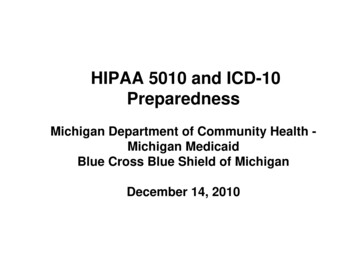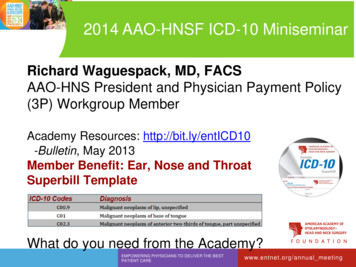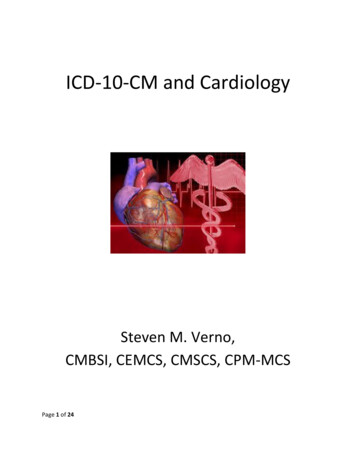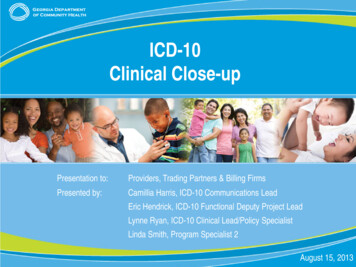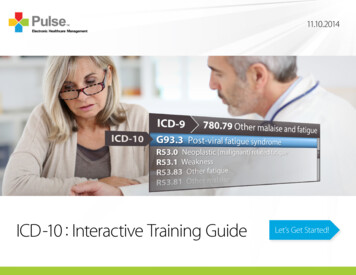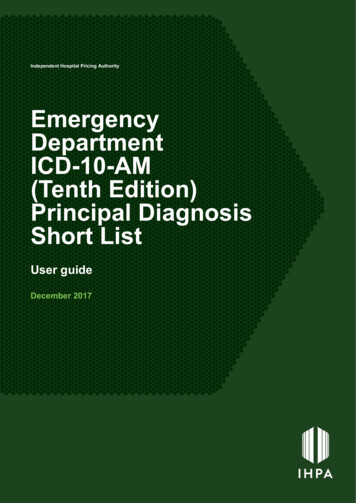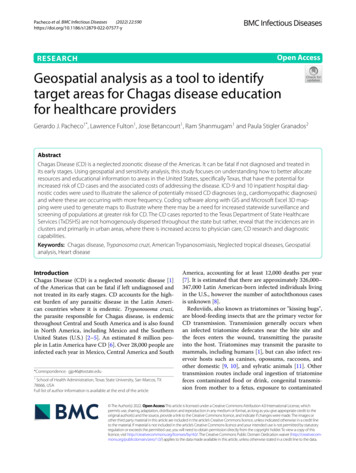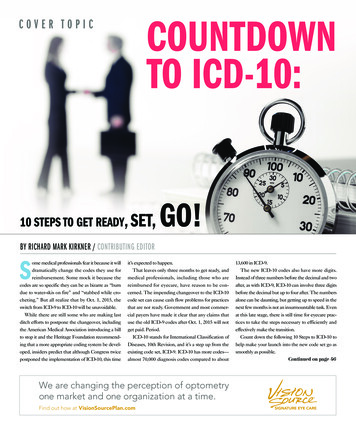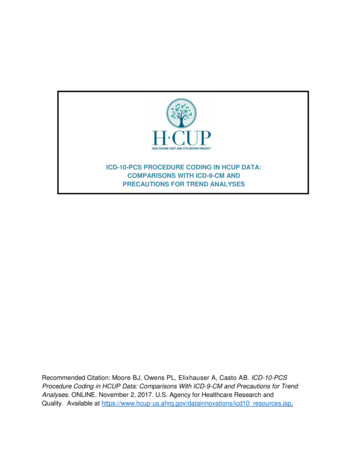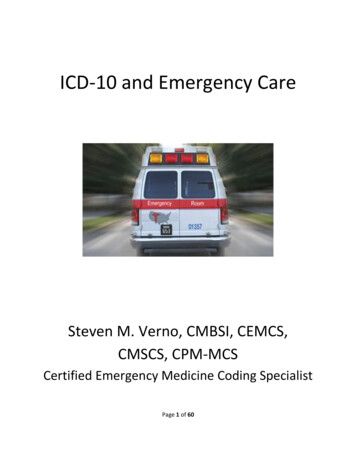
Transcription
Welcome toICD-10 CLINICALCLOSE-UP
Topics ICD-10 Overview About ICD-10Why ICD-10 Matters ICD-9 vs ICD-10ClinicalClose-Up ICD-10 Documentation GEMs Mapping Tool GEMS vs Coding ManualBi-Directional GEMSCode Translator Examples Crosswalk Examples Hospital & Physician Coding ExamplesSpecified vs Un-specified CodingSubsequent vs Sequela Coding Benefits & Rewards of ICD-10 Compliance Resources Contact
ICD-10 Overview World Health Organization developed ICD-10 in 1994 Later adopted by Health and Human Services (HHS) and Centers for Disease Controland Prevention (CDC)ICD-10 is a provision of Health Insurance Portability and Accountability Act (HIPAA)regulations HIPAA-covered entities include health care providers, payers, clearinghouses,billing services and others that must transition to ICD-10 Moving from ICD-9 to ICD-10 - US is the last industrialized nation to adopt ICD-10 ICD-9 is outdated - limited capacity, capability, and unable to serve future needs ICD-10-CM and ICD-10-PCS code sets ICD-10-CM replaces ICD-9-CM (Volumes 1 and 2)ICD-10-PCS replaces ICD-9-CM (Volume 3) ICD-10 has no direct impact on Current Procedural Terminology (CPT) codesand Healthcare Common Procedure Coding System (HCPCS)
ICD-10 Overview For services rendered on or after October 1, 2015 All claims must use ICD-10 codes Claims using ICD-9 codes for services rendered on or after October 1,2015 will NOT be accepted For services rendered before October 1, 2015 All claims must use ICD-9 codes Systems must accommodate BOTH ICD-9 and ICD-10 codes Effective with the October 1, 2015 compliance date Significant Code Increase from ICD-9 to ICD-10 Increasing from 14,000 to approximately 69,000 ICD-10-CM codes Increasing from 3,000 to approximately 87,000 ICD-10-PCS codes ICD-10 has more than nine times the codes in ICD-9
About ICD-10Why is the transition necessary? ICD-9 code sets are outdated, limited andnot expandable ICD-9 cannot accommodate current needsnor future advances in medical technologyand knowledgeMaking thetransitionto ICD-10 isNOT optional ICD-10 code sets use current medicalterminology and will allow for advances inmedical technology and knowledge ICD-10 allows for greater detail in diagnosesand treatments
Why ICD-10 MattersWhy ICD-10 Matters: ICD-10 advances health care and the implementation ofeHealth initiatives ICD-10 captures advances in medicine and medicaltechnology ICD-10 improves data for quality reporting ICD-10 improves public health research, reporting andsurveillance
ICD-9-CM vs ICD-10-CMICD-9-CMICD-10-CM3-5 characters in length3-7 characters in lengthApproximately 14,000 codesApproximately 69,000 available codes1st character alpha or numericCharacters 2-5 numeric1st Character alpha2nd Character numeric3rd Character alpha or numericCharacters 4-7 alpha or numeric7th Character extension episode of careLimited Space to add new codesFlexibility to add new codesLacks detailVery specificLacks lateralityAllows lateralityNon-specified codification issues: Difficult to analyze data Difficult to support researchImproved accuracyNot interoperable with other industrializednations who have adopted ICD-10Interoperable with the global health carecommunity and has been adopted in 99countries
ICD-9-CM vs ICD-10-PCSICD-9-CMICD-10-PCS3-4 characters in length7 alpha-numeric characters in lengthApproximately 3,000 codesApproximately 87,000 available codesBased on outdated technologyReflects current usage of medical terminologyand devicesLimited space for adding new codesFlexible for adding new codesLacks detailVery specificLacks lateralityEnables lateralityGeneric terms for body partsDetailed descriptions for body partsLacks description of methodology and approachfor proceduresProvide detailed descriptions of methodologyand approach for proceduresLacks precision to adequately defineproceduresPrecisely defines procedures with detailregarding body part, approach, any device used,and qualifying information
ICD-10 Documentation Transitioning to ICD-10 Is more than an administrative burdenplaced on your medical claimsreimbursements Should not affect the way you providepatient care Specificity and Documentationare vital in ICD-10 Look at the codes used most oftenin your practice Most of the information needed for documentation is likely shared by the patientduring your visit with them Improving how you document your clinical services will help you becomeaccustomed to the specific, detailed, clinical documentation needed to assignICD-10 codes Work with your coding staff to determine if the documentation would be detailedand specific enough to select the best ICD-10 codes Identify and obtain the training needed for you and others in your practice Good documentation will help to reduce the need to follow-up on submitted claims –saving you time and money
What are GEMs? GEMS – General Equivalency Mappings A tool used to convert data from ICD-9-CM to ICD-10-CM and ICD-10-PCS and vice versa Also known as crosswalks providing important information linking codes of one systemwith codes in the other system A comprehensive translation dictionary used to assist in translating any ICD-9-CM-baseddata, including data for: Tracking quality Recording morbidity/mortality Calculating reimbursement Converting any ICD-9-CM-based application to ICD-10-CM/PCS such as: Payment systems Payment and coverage edits Risk adjustment logic Quality measures and a variety of research applications involving trend GEMs.html
GEMs vs Coding Manual GEMs are not a substitute for learning how to use ICD-10-CM and ICD-10PCS. Providers’ coding staff will assign codes describing the patients’ encounters from the ICD10-CM and ICD-10-PCS code books or encoder systems. In coding individual claims, it will be more efficient and accurate to work from the medicalrecord documentation and then select the appropriate code(s) from the coding book orencoder system. GEMs is a tool to assist with converting larger International Classification of Diseases, 9thEdition, Clinical Modification (ICD-9-CM) databases to ICD-10-CM and ICD-10-PCS. Not all codes map in GEMs. Example: ICD-9-CM code 707.25 (pressure ulcer, un-stageable) does not map to any ICD-10CM code because ICD-10-CM classifies pressure ulcers by site and stage. ICD-10-CM does include codes for un-stageable pressure ulcers (l89.-), but ICD-9-CM doesnot include any site designation. As a result, the GEMs cannot pick a close match. Coders can map from a specific concept to a more general one. Coders cannot map to added specificity when the original information isgeneral.
Why Do GEMs Go in Both Directions? From ICD-9-CM to ICD-10 and ICD-10 back to ICD-9-CM GEMs are designed to be used like a bi-directional translation dictionary. Theygo in both directions so that you can look up a code to find out what it meansaccording to the concept and structure used by the other coding system. The bi-directional GEMS dictionaries are NOT a mirror image of each other. Thetranslation alternatives are based on the meaning of the code you are lookingup. GEMS Update CMS and CDC made a commitment to update the GEMs annually along with theupdates to ICD-10-CM/PCS during the transition period prior to ICD-10implementation.GEMs will be maintained for at least 3 years beyond October 1, 2015, which isthe compliance date for implementation of ICD-10-CM/PCS for all HealthInsurance Portability and Accountability Act (HIPAA)-covered entities.Source: /GEMs-CrosswalksBasicFAQ.pdf
Code Translator Examples The ICD-10 online translation tools allow you to compare ICD-9 toICD-10 codes. General Equivalence Mappings (GEMs) - www.CMS.gov/icd10 Code Conversion Tools: http://www.icd10data.com/ http://www.icd10codesearch.com/ https://www.aapc.com/icd-10/codes/ http://www.lussierlab.org/Web-Tools/index.html Keep in mind that while many codes in ICD-9-CM map directly to codes inICD-10, in some cases, a clinical analysis may be required to determinewhich code or codes should be selected for your mapping. The most accurate coding is accomplished using the ICD-10 codingmanuals.External links are not affiliated with the Bureau for Medical Services. Links are intended for provider convenience only.
Code Translator ExamplesExample of ICD-10 Code Translator:
Crosswalk Example: Hospital Procedures CodesICD-9-CMICD-10-PCSExamplesExamples 01.23 – Reopening Craniotomy Site 0WJ10ZZ – Inspection of CranialCavity – Open approach 12.12 – Other Iridotomy 089C30Z – Drainage of Right Iriswith Drainage DevicePercutaneous Approach 089C3ZZ – Drainage of Right IrisPercutaneous Approach 089D30Z – Drainage of Left Iriswith Drainage DevicePercutaneous Approach Additional codes as well
Crosswalk Example: Hospital Procedures CodesICD-9-CMICD-10-PCSExamples17.12 – Laparoscopic repair ofindirect Inguinal Hernia with graftor prosthesisExamples 0YU547Z – Supplement RightInguinal Region with AutologousTissue Substitute, PercutaneousEndoscopic Approach 0YU54JZ – Supplement of RightInguinal Region with SyntheticSubstitute, PercutaneousEndoscopic Approach Additional codes as well
Crosswalk Example: Physician CodesICD-9-CM CodeICD-10-CM CodesExamplesExamples 250.53 – Diabetes with ophthalmicmanifestations, type I [juvenile type],uncontrolled E10.311 – Type 1 diabetes mellituswith unspecified diabetic retinopathywith macular edemaE10.319 – Type 1 diabetes mellituswith unspecified diabetic retinopathywithout macular edemaE10.321 – Type 1 diabetes mellituswith mild nonproliferative diabeticretinopathy with macular edemaAdditional codes as well
Specified Codes The question providers should ask themselves about the code: “Does the code reflect as accurately and precisely as possible the patient’scondition or the services performed to maintain or improve that condition?” Please keep in mind: The use of codes with a greater number of characters does not necessarilyprovide greater specificity. Example Some codes that are only 3 characters are very specific while some thatare 7 characters are very vague. A91 – Denque hemorrhagic fever T75.89XD – Other specified effects of external causes, subsequentencounter Always choose the most specific code possible for each encounter. Be sure to document the side of the body involved or document that it isbilateral, if applicable.
Specified vs Unspecified ExamplesICD-9-CM CodeICD-10-CM Codes808.3 – Open fracture of pubis S32.511B – Fracture of superiorrim of right pubis, initialencounter for open fracture S32.512B – Fracture of superiorrim of left pubis, initial encounterfor open fracture S32.591B – Other specifiedfracture of right pubis, initialencounter for open fracture Additional codes as well
Specified vs Unspecified examplesICD-9-CM CodeICD-10-CM Codes808.3 – Open fracture of pubis S32.501B – Unspecified fractureof right pubis, initial encounterfor open fracture S32.502B – Unspecified fractureof left pubis, initial encounter foropen fracture S32.509B – Unspecified fractureof unspecified pubis, initialencounter for open fracture Additional codes as well
Subsequent Codes vs Sequela Codes Subsequent Codes A subsequent visit is any encounter beyond the initial visit for the samediagnosis. Sequela Codes (Late Effect) A sequela is the residual effect (condition produced [by]) the acutephase of an illness or injury. There is no limit on the sequela codes thatcan be used. The residual may be apparent early or it may occurmonths or years later such as that due to previous injury. Coding ofsequela generally requires two codes sequenced in the following order: The condition or nature of the sequela [illness or injury that causedthe sequela] is sequenced first, the sequela code is sequencedsecond.Source: /ICD10SmallandMediumPractices508.pdf
Subsequent vs Sequela Code ExamplesSubsequent Code Examples:Initial: S82.821A – Torus fracture of lower end of right fibula, initial encounter forclosed fractureSubsequent: S82.821G – Torus fracture of lower end of right fibula, subsequentencounter for fracture with delayed healingSequela Codes (Late Effect) Examples:Initial: I63.031A – Cerebral infarction due to thrombosis of right carotid arteryImmediate Sequela: I69.320S – Aphasia following cerebral infarctionImmediate and Late Sequela: I69.352S – Hemiplegia and hemiparesis following cerebral infarctionaffecting left dominant side
Rewards of ICD-10 Compliance Continued cash flows with claims processed and paid Financial statement stability, credit worthiness Increased efficiencies in administrative, billing andreimbursement processes Reduced coding errors due to increased specificity Improvement in patient care management Improved health care IT system, return on investment andincreased productivity Increased capability to prevent and detect health care fraudand abuseSource: /ICD10Payers508.pdf
ICD-10 Resources
ICD-10 ResourcesCenters for Medicare & Medicaid Services (CMS) CMS ICD-10 Main Pagehttp://www.cms.gov/ICD10 CMS tatute Regulations.html CMS ICD-10 Implementation roviderResources.html HHS, CMS ICD-10 Final Rule and October 1, 2015 Compliance 4-08-04/pdf/2014-18347.pdfWorld Health Organization (WHO) ICD-10 Pagehttp://www.who.int/classifications/icd/en/West Virginia Resources WV Molina Medicaid Solutions ICD-10 Transition ransition.aspx
ContactMolina Provider Relations UnitMolina Medicaid Solutions(304) 348-3360 or 1 (888) 483-0793Terrie Randolph, Molina Provider (304) 348-3251Cary Johnson, Molina Provider 4) 348-327725
Example: ICD-9-CM code 707.25 (pressure ulcer, un-stageable) does not map to any ICD-10-CM code because ICD-10-CM classifies pressure ulcers by site and stage. ICD-10-CM does include codes for un-stageable pressure ulcers (l89.-), but ICD-9-CM does not include any site designation. As a result, the GEMs cannot pick a close match.
